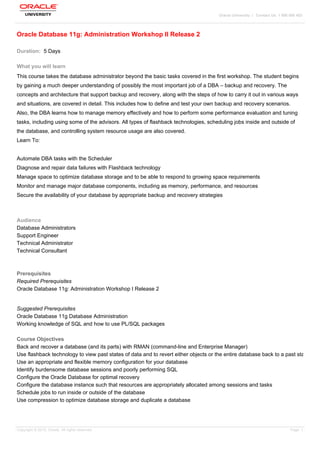Oracle Database 11g Administration Workshop Ii Release 2
- 1. Oracle University | Contact Us: 1 800 005 453
Oracle Database 11g: Administration Workshop II Release 2
Duration: 5 Days
What you will learn
This course takes the database administrator beyond the basic tasks covered in the first workshop. The student begins
by gaining a much deeper understanding of possibly the most important job of a DBA – backup and recovery. The
concepts and architecture that support backup and recovery, along with the steps of how to carry it out in various ways
and situations, are covered in detail. This includes how to define and test your own backup and recovery scenarios.
Also, the DBA learns how to manage memory effectively and how to perform some performance evaluation and tuning
tasks, including using some of the advisors. All types of flashback technologies, scheduling jobs inside and outside of
the database, and controlling system resource usage are also covered.
Learn To:
Automate DBA tasks with the Scheduler
Diagnose and repair data failures with Flashback technology
Manage space to optimize database storage and to be able to respond to growing space requirements
Monitor and manage major database components, including as memory, performance, and resources
Secure the availability of your database by appropriate backup and recovery strategies
Audience
Database Administrators
Support Engineer
Technical Administrator
Technical Consultant
Prerequisites
Required Prerequisites
Oracle Database 11g: Administration Workshop I Release 2
Suggested Prerequisites
Oracle Database 11g Database Administration
Working knowledge of SQL and how to use PL/SQL packages
Course Objectives
Back and recover a database (and its parts) with RMAN (command-line and Enterprise Manager)
Use flashback technology to view past states of data and to revert either objects or the entire database back to a past state
Use an appropriate and flexible memory configuration for your database
Identify burdensome database sessions and poorly performing SQL
Configure the Oracle Database for optimal recovery
Configure the database instance such that resources are appropriately allocated among sessions and tasks
Schedule jobs to run inside or outside of the database
Use compression to optimize database storage and duplicate a database
Copyright © 2010, Oracle. All rights reserved. Page 1
- 2. Course Topics
Core Concepts and Tools of the Oracle Database
The Oracle Database Architecture: Overview
ASM Storage Concepts
Connecting to the Database and the ASM Instance
DBA Tools Overview
Configuring for Recoverability
Purpose of Backup and Recovery (B&R), Typical Tasks and Terminology
Using the Recovery Manager (RMAN)
Configuring your Database for B&R Operations
Configuring Archivelog Mode
Configuring Backup Retention
Configuring and Using a Flash Recovery Area (FRA)
Using the RMAN Recovery Catalog
Tracking and Storing Backup Information
Setting up a Recovery Catalog
Recording Backups
Using RMAN Stored Scripts
Managing the Recovery Catalog (Backup, Export, Import, Upgrade, Drop and Virtual Private Catalog)
Configuring Backup Settings
Configuring and Managing Persistent Settings for RMAN
Configuring Autobackup of Control File
Backup optimization
Advanced Configuration Settings: Compressing Backups
Configuring Backup and Restore for Very Large Files (Multisection)
Creating Backups with RMAN
RMAN backup types
Creating and Using the following:
- Backup Sets and Image Copies
- Whole Database Backup
- Fast Incremental Backup
- Configure Backup Destinations
- Duplexed Backup Sets
- Archival Backups
Restore and Recovery Task
Restoring and Recovering
Causes of File Loss
Automatic Tempfile Recovery
Recovering from the Loss of a Redo Log Group
Recovering from a Lost Index Tablespace
Re-creating a Password Authentication File
Complete and Incomplete Recovery
Other Recovery Operations
Using RMAN to Perform Recovery
Complete Recovery after Loss of a Critical or Noncritical Data File
Copyright © 2010, Oracle. All rights reserved. Page 2
- 3. Recovering Image Copies and Switching Files
Restore and Recovery of a Database in NOARCHIVELOG Mode
Incomplete Recovery
Performing Recovery with a Backup Control File
Restoring from Autobackup: Server Parameter File and Control File
Restoring and Recovering the Database on a New Host
Monitoring and Tuning RMAN
Monitoring RMAN Jobs
Balance Between Speed of Backup Versus Speed of Recovery
RMAN Multiplexing
Synchronous and Asynchronous I/O
Explaining Performance Impact of MAXPIECESIZE, FILESPERSET, MAXOPENFILES and BACKUP DURATION
Diagnosing the Database
Data Recovery Advisor (DRA)
Block Corruption
Automatic Diagnostic Repository (ADR)
Health Monitor
The ADR Command-Line Tool, ADRCI
Using Flashback Technology I
Flashback Technology: Overview and Setup
Using Flashback Technology to Query Data
Flashback Table
Flashback Transaction Query
Performing Flashback Transaction Backout
Using Flashback Technology II
Oracle Total Recall
Flashback Drop and the Recycle Bin
Performing Flashback Database
Configuring Flashback Database
Performing Flashback Database Operations
Monitoring Flashback Database
Managing Memory
Oracle Memory Structures
Oracle Database Memory Parameters
Using Automatic Memory Management
Automatic Shared Memory Management
Using Memory Advisors
Using Data Dictionary Views
Managing Database Performance
Tuning Activities
Using Statistic Preferences
Optimizer Statistics Collection
Monitor the Performance of Sessions and Services
Automatic Workload Repository (AWR)
Describing the Benefits of Database Replay
Copyright © 2010, Oracle. All rights reserved. Page 3
- 4. Managing Performance by SQL Tuning
SQL Tuning and SQL Advisors
Using SQL Tuning Advisor
SQL Access Advisor
SQL Performance Analyzer Overview
Managing Resources
Database Resource Manager: Overview and Concepts
Accessing and Creating Resource Plans
Creating Consumer Group
Specifying Resource Plan Directives, including:
- Limiting CPU Utilization at the Database Level
- Instance Caging
Activating a Resource Plan
Monitoring the Resource Manager
Automating Tasks with the Scheduler
Simplifying Management Tasks
Creating a Job, Program, and Schedule
Using Time-Based, Event-Based, and Complex Schedules
Describing the Use of Windows, Window Groups, Job Classes, and Consumer Groups
Multi-Destination Jobs
Managing Space in Blocks
Free Space Management
Monitoring Space
Compressing Data
Managing Space in Segments
Segment Creation on Demand
Additional Automatic Space-Saving Functionalit
Shrinking Segments
Segment Advisor
Managing Resumable Space Allocation
Managing Space for the Database
Using 4 KB-Sector Disks
Transporting Tablespaces
Transporting Databases
Duplicating a Database
Purpose and Methods of Cloning a Database
Using RMAN to Create a Duplicate Database
Cloning a Database from a Backup
Duplicate a Database Based on a Running Instance
Targetless Duplicating a Database
Copyright © 2010, Oracle. All rights reserved. Page 4
